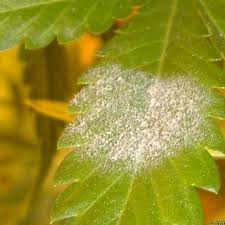“I see white powdery dust on the leaves of my plant. What is it?!”
POWDERY MILDEW
What?
Powdery Mildew is a systemic plant disease. It looks like flour was dusted on the leaves and or flowers. Not all plants get it but many, many do. You may find some varieties within one plant species don’t get the disease, while others can be devastated by it.
How?
Powdery Mildew is an airborne disease. By the time we see the white powder on the leaves the disease is at the end of its life cycle and is reproducing. The microscopic spores produced from infected plants float in the air until they land on a plant leaf and are able to get into the plant’s system and start the cycle again.
It is possible to get infected plant stock that shows no signs of the powdery mildew disease. If the plant was a cutting from an infected mother it will have the disease even if you don’t see it. It is critical to understand this.
What Now?
Proactively treating powdery mildew is the most effective way to manage the disease. This means using products before symptoms are seen. But how do you know if your plant has powdery mildew if you can’t see it yet? Well you may know from growing the plant before. Or if you received the plant as a cutting from a friend ask if the mother ever had it. Or it may be a well known fact that it is a type of plant prone to powdery mildew in your area (like roses in the Bay Area).
There are tons of products sold to treat Powdery Mildew. Many of them use a similar active ingredients but are marketed as “something special”. We will discuss the various methods, all of which are safe for use indoors, under lights and on food crops.
BENEFICIAL BACTERIA PRODUCTS
an essential part of powdery mildew control
The concept is good bacteria competes for space on and in the plant and prevents the powdery mildew disease from establishing.
- Use as early as possible in a plant’s life and use often
- Use before you see symptoms for best results
- Is effective in reducing the disease load in plants with symptoms, increasing over all vigor.
- If using a concentrate product always mix with water that is free of chlorine. Chlorine kills the good bacteria and reduces the effectiveness
- Well known products include Serenade Garden Disease Control and Actinovate Fungicide
MANAGEMENT PRODUCTS
tools to manage an existing problem or use proactively
Products that contain sulfur, potassium carbonate or various oils are ways to manage powdery mildew but often don’t completely eliminate the disease within the plant. These type of products reduce the symptoms and leave a coating on the leaf for up to 1- 2 weeks that prevents new spores from establishing.
- Oil products should only be used on vegetating strong plants, never spray with lights on or over 80 degrees. Always mix fresh.
- Sulfur products can be used during vegetation and fruiting & flowering cycles, although best to test on a small portion of the garden first.
- Potassium carbonate products can be used during vegetation and fruiting & flowering cycles, although check ingredients as it is often mixed with various oils
ENVIRONMENTAL CONDITIONS
simple ways to prevent powdery mildew from thriving
- Keep humidity between 50-60%
- Air movement in the growing environment
- Air movement with in the plant. Prune plants to reduce pockets of moisture and dank
- Use a HEPA filter on any intake fans
NUTRIENT SUPPLEMENTS
boost the plant’s over all immune system
Stronger plants are less likely to get pests and diseases. A few key products can specifically boosts your plant’s ability to deal with powdery mildew or not contract it at all.
- Silicone used in addition to a complete nutrient is essential. Silicone makes the cell wall stronger, making it harder for powdery mildew to establish and thrive with in the plant. Silicone also improves drought tolerance and stem strength. Popular silcone products include BulletProof by Cutting Edge, Armor Si by General Hydro and ProTeKt by DynaGro
- Beneficial Root Fungi and Bacteria, including mycorrhizae. Use a pinch when planting or as a root drench on plants are early as possible. Repeat application at any repot or major stress. This addition will increase the vitality of a plant and improve its immune system.
Stay Tuned………
Next post we will recommend a protocol to use in a garden where powdery mildew is an on going problem. We will also recommend a proactive protocol to use on plants to reduce the chance of having powdery mildew become a problem in your garden.

